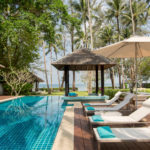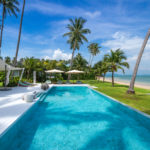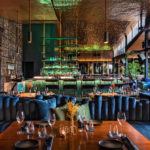It’s time to explore the open ocean! Between colourful marine life, shipwrecks, dark caves and ice ceilings, there is no telling what you’ll discover once you head under the sea. And with less known about the ocean than space, there’s every chance you’ll uncover some unknown corner of the world. To get the trip ideas pumping through your mind, we’ve pulled together the best dive sites in Asia. So, go on, hop on a boat, pull on your gear, plunge into the deep and feel that magical flying sensation, because Darling it’s better, down when it’s wetter.
#1 Barracuda Point, Sipadan Island, Malaysia
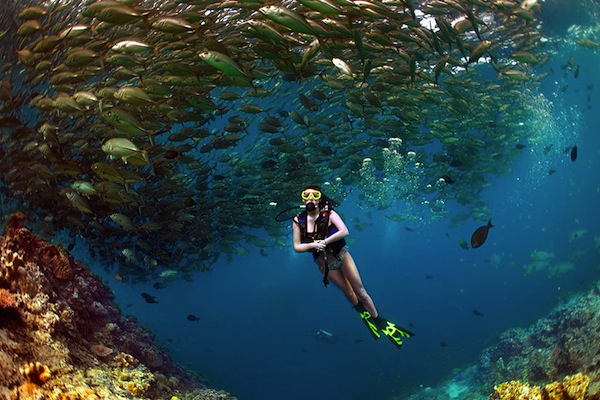
At Barracuda Point, the fish traffic is akin to the streets of Kathmandu – but underwater. You may find yourself amid an ocean (literally) of barracudas, walls of corals, flapping rays, parrotfish, grey reef sharks and an array of strange and fascinating underwater creatures.
Location: Northeast of Sipadan Island (5 minutes by boat from the beach).
Depth: 5 – 40 metres
Visibility: 20 – 30 metres
Water temperature: 26 – 30°C
Experience level: Intermediate to advanced
When to go: For peak visibility, go from March to May. Green and hawksbill turtles can be found on Sipadan island from April to September.
#2 The Yongala, Queensland, Australia
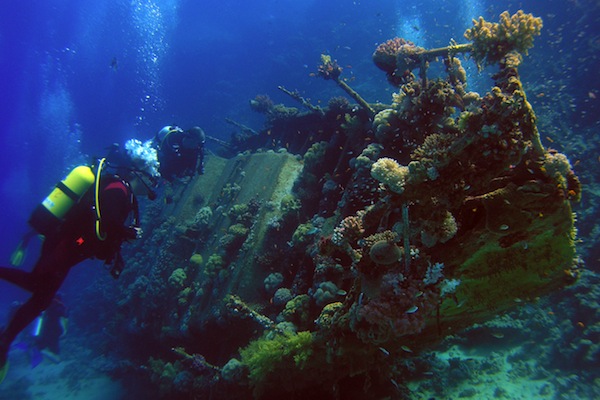
The Yongala is Australia’s largest and most intact shipwreck, and considered the best wreck dive in the world! This steamship sank during a cyclone in the Great Barrier Reef in 1911. Against the backdrop of the encrusted coral wreck, giant gropers, giant marble rays and giant trevally as large as humans gather. Amongst the abundant sea life are also barracudas, eagle rays, turtles, sea snakes, and bull sharks.
Location: 3 hours by boat from Townsville or 30 by boat minutes from Ayr, Queensland.
Depth: 25-40 metres. The ship rests on the sand 33-metres below the surface, with the top of the wreck at about 15 metres deep.
Visibility: 10 – 25 metres
Water temperature: 24 – 29°C
Experience level: Advanced
When to go: Year-round, but it can be windy in February and March.
#3 Batu Bolong, Komodo Island, Indonesia
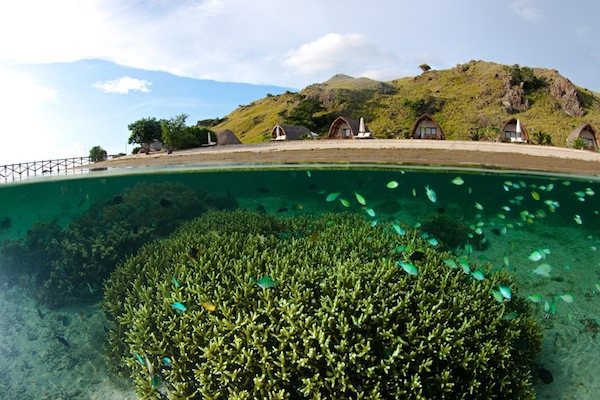
Batu Bolong features a rocky pinnacle, covered with beautiful coral growth, that lies in 75 metres of water. Due to strong currents, fishermen have avoided this area for years, ensuring that a plethora of fish call this site home. Here, divers will find rare corals, multitudes of colourful fish, reef sharks, dogtooth tuna, Napolean Wrasses, hawksbill, turtles and razor-thin electric blue palette surgeonfish.
Location: Between Tatawa Island to the east and west of Komodo’s main island.
Depth: 10 – 75 metres
Visibility: 20 – 35 metres
Water temperature: 23 – 26°C
Experience level: Intermediate to advanced
When to go: Year-round
#4 Sail Rock, Koh Samui, Thailand
View this post on Instagram
Sail Rock is a limestone pinnacle that sits approximately 40 metres below the surface and rises to 15 metres above the surface. The site is most well-known for the chimney that divers can enter at 18-metres below and then climb up before exiting at either 12- or 6-metres below. Beyond the chimney, divers can spot whale sharks, moray eels, and longfin batfish which are amongst the area’s regular visitors. Don’t miss the swarms of tuna and mackerel!
Location: 50 minutes from Koh Samui, between Koh Phangan and Koh Tao.
Depth: 5 – 40 metres
Visibility: 10 – 30 metres
Water temperature: 26 – 29°C
Experience level: Beginner to advanced
When to go: Year-round
#5 North Horn, Osprey Reef, Australia
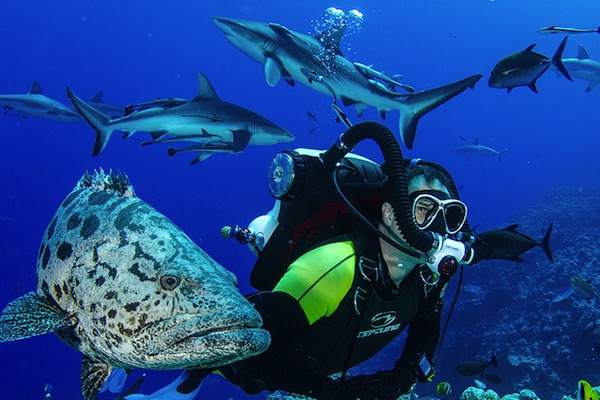
An underwater coral atoll in pristine waters, North Horn is home to a variety of sharks. These include hammerheads, tigers, white tip and silvertip sharks – the experience will get your adrenaline pumping. Whale sharks, sperm whales and bottlenose dolphins also make frequent appearances here. The reef walls of the area are covered in soft corals and gorgonian fans (some of which have a span of two metres!).
Location: Osprey Reef is located 350 kilometres from Cairns and on the outer Great Barrier Reef. Due to the distance, it’s only accessible via a liveaboard.
Depth: 15 metres
Visibility: 25 – 40 metres
Water temperature: 27 – 29°C
Experience level: Intermediate to Advanced
When to go: Year-round, but it can be windy in February and March.
Read also: A beginner’s guide to liveaboard diving
#6 Shark Point, Phuket, Thailand

Named for the leopard sharks that frequent this area, the site is made up of three pinnacles running from north to south. Shark Point has giant gorgonian fan coral some of which are as big as 3 metres in diameter. Stingrays and cuttlefish take up residence amongst the pinnacles. Whale sharks and spotted eagle rays have been seen here.
Location: 25 kilometres east of Phuket’s Chalong Bay.
Depth: 10 – 30 metres
Visibility: 2 – 25 metres
Water temperature: 27 – 30°C
Experience level: Intermediate to advanced
When to go: Year-round
#7 Maaya Thila, Ari Atoll, Maldives

Known to many due to its exotic underwater flora and fauna – it is dubbed the ‘White Tip Reef Shark Capital of the Maldives’. A playground made for sea creatures, expect to be captivated by spectacular and up-close views of a diverse range of tropical fishes, whale sharks, dogtooth tuna, manta rays, turtles and the giant Napoleon Wrasse. Plus point: the Maaya Thila has is considered as one the best night diving spots in the world!
Location: 8 kilometres to the northwest of Ukulhas island.
Depth: 6 – 30 metres
Visibility: 10 – 30 metres
Water temperature: 26 – 29°C
Experience level: Beginner
When to go: Year-round, but for the calmest seas go from December to May.
#8 Kakaban Island, East Kalimantan, Indonesia

Kakaban Island is a World Heritage Site with a truly unique geology and an abundance of marine species. Within the island is a large lake that over two million years has evolved from a lagoon to a saltwater lake to a lake of brackish water. As a result, life here has evolved separately from the rest of the world. And the jellyfish here are particularly interesting. Without predators, the jellyfish have lost their sting, and you can swim your way through thousands of them without fear of being stung.
If swimming with jellyfish isn’t your idea of fun, on the outside of the island, you can find deep wall dive where the island’s limestone cliffs drop into the abyss. Here, discover schools of barracuda, tuna and sharks.
Location: Off the coast of East Kalimantan.
Depth: Up to 18 metres
Visibility: 15-20 metres
Water temperature: 26 – 29°C
Experience level: Intermediate to advanced
When to go: Year-round, but March to October sees the best visibility.
#9 Three Bears, Koh Tang, Cambodia
View this post on Instagram
A favourite site on the famous diving island of Koh Tang, Three Bears gets its name from the classic children’s tale of Goldilocks and the Three Bears – within a cave there are three formations, a tall one with two slightly smaller ones on either side. The reef here starts at 2 metres deep with lots of bright coral and a plethora of fish like batfish, trevally and barracuda. The reef extends to 16 metres deep.
Location: Four to five hours from Sihanoukville, off the coast of mainland Cambodia.
Depth: 2 – 16 metres
Visibility: 10 – 30 metres
Water temperature: 28 – 30°C
Experience level: Beginner to intermediate
When to go: December – April.
#10 Black Rock, Mergui Archipelago, Myanmar

An eighty-metre long islet, Black Rock is an absolute big fish magnet. It is most famous for the schools of manta and eagle rays, along with marble stingrays and leopard sharks that frequent the area. The rock extends into the depths of the ocean and features soft corals. Great boulders protect a wide variety of marine life like orange cup corals, feather stars, gorgonian sea fans, and tiger-striped anemones.
Location: 160 kilometres northwest of Kawthaung in Southern Myanmar.
Depth: 10 – 50 metres
Visibility: 20 -50 metres
Water temperature: 26 – 30°C
Experience level: Intermediate to advanced
When to go: Liveaboards only operate from October to May. Manta rays and whale sharks frequent the area from February to May.
#11 The Wall, Havelock, Andaman Islands, India

This 50-metre long reef wall lies near a jetty on Havelock. The top of the wall is teeming with life with colourful fish and creatures ranging from pufferfish to scorpionfish, octopi and triggerfish. Closer to the bottom, there are whitetip sharks, barracuda and trevally. Within the area, sea turtles and manatee sightings have been reported.
Location: Although part of India, Havelock is closer to Myanmar and Sumatra.
Depth: 5 – 30 metres
Visibility: 5 – 40 metres
Water temperature: 27 – 30°C
Experience level: Beginner to advanced
When to go: December to April
#12 The Liberty, Tulamben, Bali, Indonesia

In 1942, US Army Transport ship, The Liberty was torpedoed by a Japanese submarine and now lies just off the shore of Bali. The wreck rests in 30 metres of water, and the top of it can be seen from the surface. A wide range of corals and invertebrates call the wreck home attracting all sorts of marine life, from small fish to mola mola.
Location: 25 metres off the shore of Tulamben. It can be reached via the short swim.
Depth: up to 30 metres
Visibility: 15 – 25 metres
Water temperature: 26 – 30°C
Experience level: Beginner to advanced
When to go: October and November although May to July is also a good time to visit.
#13 Ijyakajya, Kerama Islands, Okinawa, Japan
View this post on Instagram
Manta rays come to this spot in Japan to be cleaned. The rays can spend hours each day getting their skin, gill and teeth cleaned by parasitic copepods and will wait in line for their turn. Stay as still as possible and watch as the rays filter in and out. When you’re done, there are at least fifty diving spots in Kerama, so charter a boat and hop from spot to spot.
Location: 40 kilometres west of Naha City in Okinawa.
Depth: Up to 30 metres
Visibility: 50 – 60 metres
Water temperature: 21 – 28°C
Experience level: Beginner
When to go: May to October
#14 Lion City, Qiandao Lake, Zhejiang Province, China

Dubbed China’s Atlantis, dive here and revisit the Lion City, which was built during the Dong Han period (25 – 200CE). The ancient and surprisingly well-preserved city was flooded by the construction of Xin’Anjiang Dam in September 1959 and has since come to rest 30 metres under the sea.
Location: Approximately 400 kilometres southwest of Shanghai.
Depth: 26 – 40 metres
Visibility: 2 – 5 metres
Water temperature: 14 – 28°C, with the temperature peaking in July and August.
Experience level: Advanced
When to go: April to October, although, for the best visibility go from April to June.
#15 Cape Kri, Raja Ampat Islands, Indonesia
Want to get wrapped up in a blanket of fish? This site, which features a sloping reef wall is known to have the widest range of marine life in the Raja Ampat area. There are almost always large schools of fish passing through and 283 different marine species have been recorded on a single dive here. At the base of the reef, an ancient anchor can be found, snagged on the ground.
Location: Off the western coast of West Papua.
Depth: 5 – 40 metres
Visibility: 10 – 30 metres
Water temperature: 27 – 30°C
Experience level: Intermediate to advanced
When to go: October to April
#16 Shark Airport, Tubbataha Reef National Marine Park, Philippines

Considered one of the most marine life-rich dive sites in Tubbataha, the UNESCO World Heritage-listed marine park, Shark Airport is a vast plateau at 15 metres below the surface that drops off to a shelf at 25 metres deep. Here, whitetip sharks cruise the shallows and hawksbill, and green turtles investigate the corals. The spot is particularly popular for night diving as moray eels and black-spotted pufferfish call this site home.
Location: 10 hours from Puerto Princesa by dive boat.
Depth: 3 – 30 metres
Visibility: 30 – 45 metres
Water temperature: 28 – 30°C
Experience level: Beginner to advanced
When to go: The reef can only be accessed from March to June.
#17 Coral Island, Pulau Tioman, Malaysia

A volcanic island in the South China Sea, Coral Island has several reefs, all with coral gardens and absolutely teeming with marine life. For those who love Nemo, clownfish are abundant here as countless anemones within the reefs house these gorgeous creatures. The spot can be quite shallow, so it’s great for snorkellers as well.
Location: A two-hour ferry (or 45 minutes by speedboat) ride from Mersing in Malaysia.
Depth: Up to 30 metres
Visibility: 15 – 30 metres
Water temperature: 27 – 29°C
Experience level: Beginner to intermediate.
When to go: You can dive here from February to November, but for the best visibility go from either March to May or September to November.
#18 Bida Nai, Phi Phi Islands, Thailand
Also known as Inner Father Island, this limestone island which rises high above the surface features underwater walls covered in clams, gorgonian fans and sea whips. Boulders throughout the site form stunning swim-throughs, and the surrounding coral is bursting with fish. In the depths, you can find leopard and blacktip reef sharks, and in the shallows, keep an eye out for lionfish, turtles and bamboo sharks under coral covered rocks.
Location: About three hours east of Phuket by boat.
Depth: 10 – 25 metres
Visibility: 10 – 30 metres
Water temperature: 27 – 30°C
Experience level: Beginner to intermediate
When to go: Conditions are typically good year-round but go from February to May for the best conditions.
#19 Shiretoko Peninsula, Hokkaido, Japan

Fish and marine life are great and all, but ice diving is an activity unlike any other. On the Shiretoko Peninsula, don a drysuit and dive beneath a ceiling of ice. On sunny days, the sun will penetrate the ice creating a mystical glow as cliones, commonly referred to as sea angels, swim about.
Location: Northeastern Hokkaido.
Depth: Up to 15 metres
Visibility: 10 – 20 metres
Water temperature: 3 – 20°C
Experience level: Advanced
When to go: February to March is ideal as winter ice will have begun to break up by this point.
#20 Madonna Rock, Nha Trang, Vietnam

A rocky outcrop off of Vietnam’s Hon Mun Island, marine life flourishes here. The site is best known for having many caves at different depths that divers can access. Many of the caves act as breeding grounds for various fish species – with some caves quite tightly packed. The sun’s reflection in the caves can give the area a rather mysterious glow.
Location: A one-hour boat ride from Nha Trang.
Depth: 5 – 25 metres
Visibility: 5 – 20 metres
Water temperature: 26 – 29°C
Experience level: Beginner to intermediate
When to go: February and September

